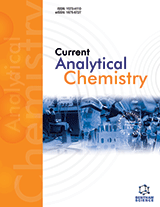摘要
背景:多酚可能是在我们的饮食中分子营养研究兴趣中最知名的微量元素。地中海饮食中的一些最重要的食物来源是橄榄和橄榄油。越来越多的证据从动物模型的临床研究表明,多酚化合物可能有神经保护作用,在几个病理的神经系统通过控制氧化应激,炎症,细胞凋亡和线粒体功能障碍。 目的:基于最新的科学文献,多酚摄入量减轻氧化应激,减少诸如阿尔茨海默氏症相关的神经退行性疾病的风险,帕金森病,中风,多发性硬化症和亨廷顿病。在外周水平上,他们作为抗氧化剂,保护组织免受氧化损伤和清除自由基。 结果:最近的结果在动物模型和人类显示可能多酚类在调节神经营养因子的水平中扮演重要角色,特别是神经生长因子(NGF)和脑源性神经营养因子(BDNF),显示多酚类通过神经营养因子的潜在作用引起他们的保护效果。神经生长因子和脑源性神经营养因子,主要是已知作为生物介质刺激神经元的生长,增殖,存活和分化,最近研究代谢因素的作用,对葡萄糖和能量代谢,胰腺β细胞与心血管稳态。 结论:在这种情况下,对神经营养素及其受体(TrkA,TrkB多酚的影响,p75NTR)一个更好的理解可以用于药物发现也让我们对一些神经系统和心血管疾病的潜在饮食预防产生兴趣。
关键词: 橄榄多酚羟基酪醇,神经营养因子,神经保护,氧化应激,心血管疾病。
Current Medicinal Chemistry
Title:Neurotrophins' Modulation by Olive Polyphenols
Volume: 23 Issue: 28
Author(s): Valentina Carito, Mauro Ceccanti, Luigi Tarani, Giampiero Ferraguti, George N. Chaldakov, Marco Fiore
Affiliation:
关键词: 橄榄多酚羟基酪醇,神经营养因子,神经保护,氧化应激,心血管疾病。
摘要: Background: Polyphenols are probably the most known and investigated molecules of nutritional interest as micronutrients present in abundance in our diet. Some of the most important food sources of polyphenols in the Mediterranean diet are olives and olive oil. A growing body of evidence from animal models to clinical studies indicates that polyphenol compounds may have neuroprotective effects in several pathologies of the nervous system through the control of oxidative stress, inflammation, apoptosis and mitochondrial dysfunction.
Objective: Based on the most recent scientific literature, dietary intake of polyphenols attenuates oxidative stress and reduces risk for related neurodegenerative diseases such as Alzheimer’s disease, Parkinson’s disease, stroke, multiple sclerosis and Huntington’s disease. Also at the peripheral level, they act as antioxidant, defending tissues against oxidative damage and scavenging free radicals.
Results: Recent findings in animal models and humans show that polyphenols may have a role in regulating neurotrophins levels, in particular nerve growth factor (NGF) and brainderived neurotrophic factor (BDNF), suggesting that polyphenols may also induce their protective effects through the potentiation of neurotrophins action. NGF and BDNF, primarily known as biological mediators stimulating neuron growth, proliferation, survival and differentiation are recently studied also as metabotrophic factors, acting on glucose and energy metabolism, pancreatic beta cells and cardiovascular homeostasis.
Conclusion: In this context, a better understanding of the effects of polyphenols on neurotrophins and their receptors (TrkA, TrkB, p75NTR) could certainly generate interest for drug discovery and also for the potential dietary prevention of several neurological and cardiometabolic diseases.
Export Options
About this article
Cite this article as:
Valentina Carito, Mauro Ceccanti, Luigi Tarani, Giampiero Ferraguti, George N. Chaldakov, Marco Fiore , Neurotrophins' Modulation by Olive Polyphenols, Current Medicinal Chemistry 2016; 23 (28) . https://dx.doi.org/10.2174/0929867323666160627104022
| DOI https://dx.doi.org/10.2174/0929867323666160627104022 |
Print ISSN 0929-8673 |
| Publisher Name Bentham Science Publisher |
Online ISSN 1875-533X |
 49
49 4
4
- Author Guidelines
- Graphical Abstracts
- Fabricating and Stating False Information
- Research Misconduct
- Post Publication Discussions and Corrections
- Publishing Ethics and Rectitude
- Increase Visibility of Your Article
- Archiving Policies
- Peer Review Workflow
- Order Your Article Before Print
- Promote Your Article
- Manuscript Transfer Facility
- Editorial Policies
- Allegations from Whistleblowers
- Announcements
Related Articles
-
Similar Mechanisms Regulated by γ-Secretase are Involved in Both Directions of the Bi-Directional Notch-Delta Signaling Pathway as well as Play a Potential Role in Signaling Events Involving Type 1 Transmembrane Proteins
Current Stem Cell Research & Therapy New Drugs for HDL-C Disorders: The Beginning
Current Medicinal Chemistry Molecular and Biochemical Changes of the Cardiovascular System due to Smoking Exposure
Current Pharmaceutical Design Targeting the Coagulation Factor Fibrinogen for Arthritis Therapy
Current Pharmaceutical Biotechnology Effect of Androgenic and Antiandrogenic Acting Compounds in Macrophage Accumulation and Cell Replication in the Aorta of Oophorectomized Hypercholesterolemic Rabbits
Vascular Disease Prevention (Discontinued) Characteristics Other than the Diagnostic Criteria Associated with Metabolic Syndrome: An Overview
Current Vascular Pharmacology The Effects of Vitamin B in Depression
Current Medicinal Chemistry Phenothiazines as Anti-Multi-Drug Resistant Tubercular Agents
Infectious Disorders - Drug Targets Effectiveness of Psychoeducational Interventions for Improving Symptoms, Health-Related Quality of Life, and Psychological well Being in Patients with Stable Angina
Current Cardiology Reviews NO Signaling Through cGMP in Renal Tissue Fibrosis and Beyond: Key Pathway and Novel Therapeutic Target
Current Medicinal Chemistry Screening Haemostasis – Looking for Global Assays: The Overall Haemostasis Potential (OHP) Method – A Possible Tool for Laboratory Investigation of Global Haemostasis in Both Hypo- and Hypercoagulable Conditions
Current Vascular Pharmacology Insulin Resistance and Polycystic Ovary Syndrome Through Life
Current Pharmaceutical Design Semicarbazide-Sensitive Amine Oxidase/Vascular Adhesion Protein 1: Recent Developments Concerning Substrates and Inhibitors of a Promising Therapeutic Target
Current Medicinal Chemistry Reporting and Interpretation of the CYP2C19 Genotyping Test for Clopidogrel Dosing
Current Pharmacogenomics and Personalized Medicine Computed Tomography Imaging of the Coronary Arteries: State of the Art Applications and Recent Patents
Recent Patents on Medical Imaging Chronic Hypoxia Potentiates Age-Related Oxidative Imbalance in Brain Vessels and Synaptosomes
Current Neurovascular Research Dietary Prevention of Coronary Heart Disease
Current Medicinal Chemistry - Immunology, Endocrine & Metabolic Agents Tofacitinib, an Oral Janus Kinase Inhibitor: Perspectives in Dermatology
Current Medicinal Chemistry MicroRNAs: Important Epigenetic Regulators in Osteoarthritis
Current Genomics Leptin as a Cardiac Pro-Hypertrophic Factor and its Potential Role in the Development of Heart Failure
Current Pharmaceutical Design


























